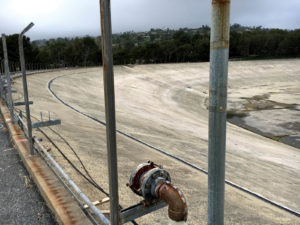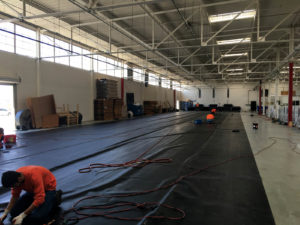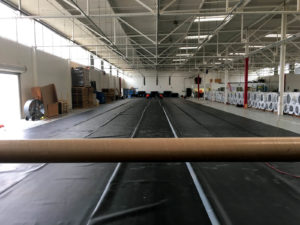
Introduction
California is home to one of the most active water resource infrastructure sectors. Geosynthetics can play an enormous role with the creation and rehabilitation of these water resources.
The 76-year-old Palos Verdes Reservoir in Los Angeles County provides an exemplary case (Photo A). The 360-million-gallon cell is currently undergoing an update that will greatly extend its service life. In this special three-part series for Geosynthetics magazine, the project team will highlight the work as it happens.
In Part 1, the project is described, with the prep, manufacturing, and fabrication stages highlighted. In Part 2, installation, testing, and quality assurance on-site will be covered. Finally, Part 3 will follow the facility as it goes into operation.
Setting the scene
Communication and planning are paramount for efficiency and economics in any project. The bar is elevated on sensitive containment projects, and even more so for one of significant scale. When geomembrane fabrication is involved, it requires substantial planning to ensure that the manufacturer, fabricator, and installer have accurate site details and specifications. This exchange with the client and among the stakeholders leads to optimal panel layouts, efficient construction practices, and streamlined quality assurance.
Along with proper material selection and installation, planning and communication are the best ways to ensure that facilities go online in the condition for which they are designed and that will lead to optimized service lives.
The Palos Verdes Reservoir project, with its scale, has required significant planning, with weekly meetings conducted with the operations manager, project manager, scheduler, and geosynthetics plant manager. Active weeks, billings, shipment details, and other related issues are covered in these meetings.
The fabrication window has been estimated at five months and fieldwork is anticipated to last seven months—including construction of geocomposite underlay, liner, and cover; assembly of accessories; and, aeration, washdown, and final chlorination.
The general contractor has been the key player involved in a 10-month window of site preparation work that prepares the grounds for the installation work to begin in the fourth quarter of 2016.
In the meantime, manufacturing of the primary chlorosulfonated polyethylene (CSPE) geomembrane materials and fabricating the panels into wide rolls was continuing in preparation for the later install on-site.
Liner and cover geomembrane
CSPE geomembranes were specified for the Palos Verdes Reservoir. For major water containment work, CSPE is now a preferred geomembrane variety, especially for dual liner and cover systems. In sun-soaked environments such as Southern California, CSPE is notable for its long-term performance record in exposed applications. It’s also a flexible geomembrane, which qualifies it for the cost advantages of factory fabrication. More rigid membrane panels will be entirely seamed on-site.
CSPE was used significantly in the 1980s—and some practitioners still refer to it by the now-retired brand name Hypalon®—but as other geomembranes gained awareness in the market, especially with the attention given to Subtitle D landfill lining work, fewer companies pushed CSPE. Today, though, with projects from the 1980s still serving as shining examples of long-term performance, the material has seen a resurgence in containment. Water storage is a leading sector, with CSPE geomembranes being adopted into major projects in Australia, New Zealand, the Middle East, and throughout North America.
The Palos Verdes Reservoir, in fact, had a CSPE floating cover since 1988. That cover was removed for replacement as these new site works were initiated.
In addition to a new CSPE geomembrane floating cover, Palos Verdes will add a CSPE lining system over a concrete liner. The previous concrete liner is being replaced with asphalt.
The new geosynthetic barrier system will utilize a 60-mil, 5-ply CSPE geomembrane. The liner will be underlain by a geonet-nonwoven geotextile composite. The floating cover replacement will be fabricated from 45-mil, 3-ply CSPE.
The floating cover design is a tensioned cover system that features weights and floats. These elements create troughs on the floating cover to funnel rainwater from its surface. The cover terminates in the mechanical batten attachment, which is also where the base liner terminates. The design essentially creates an in-ground sealed storage system. Epoxy-set anchors will ensure security at the battens.
Site characteristics and challenges
Configuration
The reservoir’s avocado shape means that for the base and slope lining system, a number of slope and floor radii will require the fabrication of multiple level panels. Also, many custom pie-shaped panels are needed for the steps.

Penetrations, structures, and appurtenances (PHOTOS B and C)
The presence of inlet/outlet structures and perimeter mechanical attachments on the liner, and the need to cap-strip all field seams with a 6-in. strip of material, presents some complications to the work, but these are not uncommon aspects in a containment facility. If they can be minimized in design, the installation work can ultimately be faster and the facility will have fewer critical control points; but, again, these types of appurtenances are not atypical.
They are planned for in the manufacturing and fabrication phases, and experienced installation and construction quality assurance (CQA) on-site manages them effectively.
Floating covers can require a lot of appurtenances. With

Palos Verdes, there is a perimeter-defined sump tensioned cover. This has necessitated planning for 50 repair floats, 32 hatches, 16 air vents, 10 vacuum vents, and 10 PVC sump pump structures for rainwater removal.
Limited land
The PV reservoir is enormous, but the usable land around the site is not substantial. It is, in fact, a residential neighborhood. This has heightened the need for limiting noise at, and transit to and from, the construction site. Furthermore, not much room is available for on-site storage of fabricated materials and construction equipment.
Given the limited site storage and the enhanced restrictions on construction activity and traffic due to the neighborhood’s proximity, the civil contractor will largely determine the allowable schedule.
In general, this is expected. When a geosynthetic lining system is installed, large sites are often bound by the need to wait on trenching, trench closure, and other typical contractor activities. (Trenches must not be left exposed overnight, for example.) So while large fabricated panels and rolled goods can be installed quickly, there is a natural limit on daily work due to standard coordination and wait times.
The community sensitivity of the Palos Verdes work, however, merits additional caution and deference to the civil contractor. The stakeholders are in agreement on this, and the weekly planning and update meetings help ensure accurate and timely provision of materials and personnel for this carefully phased work.
Manufacturing the liner
While the reservoir site is prepped for the new lining and cover system, manufacturing rolls of 5-ply, 60-mil CSPE and 3-ply, 45-mil CSPE continues, and those rolls have been delivered for fabrication.
The 5-ply material was selected by the design team for the primary liner because of its enhanced tensile strength, tear resistance, and puncture resistance qualities. It’s a better choice for high hydrostatic pressure applications, such as encountered in large liquid storage cells. The standard 3-ply construction is being utilized for the cover.

Manufacturing can custom-color its CSPE geomembranes. Some reservoirs have specified green floating covers to blend into a landscape. Some have specified tan in more arid environments. A couple facilities have even opted for a camouflage pattern. Palos Verdes specified a black geomembrane.
In making the project’s geomembranes, the manufacturer used a four-step process (see sidebar “Manufacturing the liner and cover” on page 24).
Quality controls at this stage testify to the care invested by geosynthetics manufacturers in matching the membrane to a site’s needs.
With compliance verified, the rolls were then packaged, labeled, and shipped to the fabrication plant, where the large panels were arranged into the custom widths and lengths for the most efficient install.

Fabrication vs. field seaming (PHOTOS D and E)
The fabrication of geomembrane panels in a factory can greatly improve the economics of an installation. It enables substantially larger, finished pieces to be placed on-site. Prefabrication minimizes the number of seams that must be made in the field. The process also means that the seams made in the factory are done without the environmental challenges of blowing dirt, possibly uneven subgrades, temperature and moisture fluctuations, and weather delays.
For the Palos Verdes project, fabricating was required for the 2.8 million sq.ft of liner and floating cover geomembrane.
To further enhance the economics and deliverables, a new wide-width winding system was installed. This enables the fabrication team to build 35-ft.-wide lay-flat panels.
The Palos Verdes panels are being fabricated from 800- to 1,000-ft.-long rolls into 35ft × 230ft panels for the base of the installation and 35ft × 185ft panels for the slopes. As noted, stepped panels in various pie-shaped, location-specific configurations will also be utilized at the site. The specific geometries of these panels have been determined in site planning.

and packaged. 7,875 square feet per roll / 3,800 lbs. per roll. Photo courtesy of Colorado Lining.
While the factory fabrication activity is conducted in a more climate-controlled environment than the field, the equipment used to ensure quality seams is the same. The factory activity is simply faster, as it is performed without the environmental concerns which, in the field, generally slow down the panel welding speed. Also, in the field, the blowing dirt and fluctuating moisture may necessitate cleaning of the seam path. The longer the panel section to be welded outdoors, the more it will need to be cleaned before welding can proceed.
This process of care is another standard activity that, while potentially time-consuming in the field, ensures geomembrane seam integrity.
(PHOTOS F and G)
In the fabrication center, however, the controlled environment allows large sections to be assembled by joining clean geomembrane panels. Per specification for Palos Verdes, flat panel rollup is being used rather than material folding.

The rollup of material is a special process, using a customized 38-ft bar system. The bar accommodates the wide flat panel, while a custom lifting apparatus helps to attach the massive rolls to forklifts for safe and efficient movement, warehousing, and packing.
While the sizes of rolls certainly improves the economics of the large installation, 1.5-ft-diameter, 35-ft-long rolls do present a logistical challenge for storage. But coordination between the storage facility and the site works in Palos Verdes will ensure efficiency of the process.
John Heap is the president of Parker, Colo.-based Colorado Lining International Inc.
The Palos Verdes Reservoir
The Metropolitan Water District of Southern California (MWDSC) is currently in the process of rehabilitating the Palos Verdes Reservoir, including installation of a new geomembrane liner and a geomembrane floating cover.
The reservoir, located near the intersection of Palos Verdes Drive East and Palos Verdes Drive North just south of the Pacific Coast Highway in Rolling Hills Estates, provides operational storage and hydraulic flexibility for MWDSC’s water distribution system.
The reservoir project is a key element of MWDSC’s ongoing Infrastructure Reliability Program to ensure that this distribution system continues to provide a reliable water supply for 19 million customers.
This project began in January 2016, with an expectation of completion by mid-2017.
The scope of the construction work includes:
- removal of the reservoir’s existing concrete lining.
- regrading of the clay sub-liner.
- modification of the existing spillway structure, inlet/outlet tower, and secondary inlet and outlet structures.
- installation of a new sub-drain system, an asphalt concrete lining, a geomembrane liner, and a geomembrane floating cover.
- installation of a new valve and flowmeter upstream of the reservoir.
- addition of a precast concrete instrumentation and water quality structure.
By June 2016, the general contractor was in the process of demolishing the existing pipeline and outlet structure and removing the existing concrete floor. The process at that stage also included installation of the piping underground while rebuilding the underdrains and drainage systems. This will allow water from the hillside to travel under the reservoir naturally without any upward pressure on the lining system and sub-base. The outlet works are built into the sidewall of the reservoir to facilitate a better floating cover design and installation.
The water supply to homes and businesses will not be affected.
Source: Metropolitan Water District of Southern California (MWDSC)
By Stephen Roades
Because of the hydrostatic pressure situation with the Palos Verdes Reservoir, a 5-ply, 60-mil CSPE (chlorosulfonated polyethylene or “Hypalon”) geomembrane was chosen for the liner on this project. A 45-mil/3-ply was the choice for the reservoir cover.
- The manufacturing of the materials for the Palos Verdes project consisted of four steps:
The raw materials were compounded and blended in a high-intensity mixer (Photo 1). - After mixing, the CSPE geomembrane was calendered into master rolls (Photo 2).
- The master rolls were then 100% inspected and rewound to project specifications (Photo 3).
- During the inspection process, samples were taken from each roll and spot checked and tested for compliance to specifications; full compliance testing was completed every 50,000 square feet (Photo 4).


Photo 2. CSPE on warm-up/breakdown mil prior to being fed into the calender.




After the completion of inspections, the rolls were packaged and labeled (Photo 5). Typical rolls were 800 and 1,000 feet long. The rolls for the Palos Verdes Reservoir project were then shipped to the fabrication site and prepped into custom widths and lengths prior to installation (Photo 6).
The Palos Verdes project is offering all of the contributing companies an opportunity to be involved with one of the largest and most strategically important liner/cover projects to come down the pike in a long time.
Steve Roades is vice president/Environmental Products Division at San Jose, Calif.-based Burke Industries.
 TEXTILES.ORG
TEXTILES.ORG


